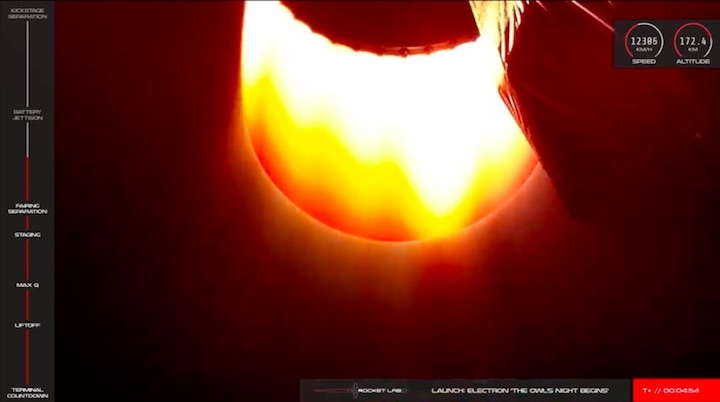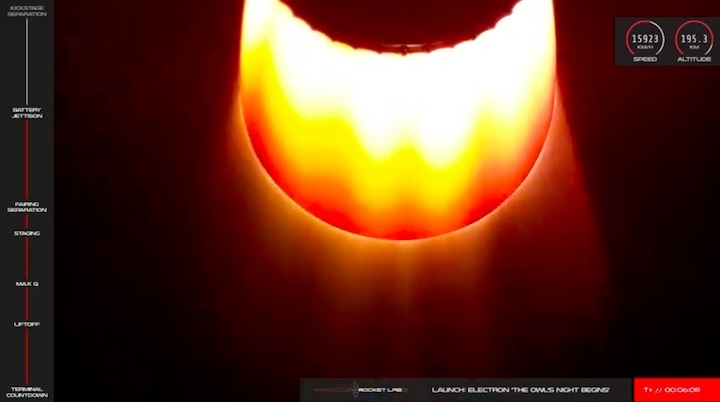25.11.2020

MISSION OVERVIEW
Rocket Lab's 17th mission is a dedicated launch for Japanese Earth-imaging company Synspective.
The mission is named ‘The Owl’s Night Begins’ in a nod to Synspective’s StriX family of synthetic aperture radar (SAR) spacecraft developed to be able to image millimetre-level changes to the Earth’s surface from space, independent of weather conditions on Earth and at any time of the day or night. Strix is also the genus of owls.
The StriX-α satellite onboard this mission will be the first of a series of spacecraft deployments for Synspective’s planned constellation of more than 30 SAR small satellites to collate data of metropolitan centers across Asia on a daily basis that can be used for urban development planning, construction and infrastructure monitoring, and disaster response.
This mission has an instantaneous launch opportunity each day of the 14-day launch window. Lift-off is currently targeted NET 12 December.


Quelle: RocketLab
----
Update: 29.11.2020
.
Rocket Lab to Launch Dedicated Mission for Japanese Earth Imaging Company Synspective

Long Beach, California. 24 November 2020 – Rocket Lab, a space technology company and global leader in dedicated small satellite launch, has today announced Japanese Earth-imaging company Synspective as the customer for Rocket Lab’s 17thElectron launch, and its seventh mission of the year.
The dedicated mission for Synspective is scheduled for lift-off during a 14-day launch window opening on 12 December UTC and will launch from Rocket Lab Launch Complex 1 on New Zealand’s Māhia Peninsula to a targeted 500km circular low Earth orbit.
The mission is named ‘The Owl’s Night Begins’ in a nod to Synspective’s StriX family of synthetic aperture radar (SAR) spacecraft developed to be able to image millimetre-level changes to the Earth’s surface from space, independent of weather conditions on Earth and at any time of the day or night. Strix is also the genus of owls.
The StriX-α satellite onboard this mission will be the first of a series of spacecraft deployments for Synspective’s planned constellation of more than 30 SAR small satellites to collate data of metropolitan centers across Asia on a daily basis that can be used for urban development planning, construction and infrastructure monitoring, and disaster response.
For this mission, Rocket Lab will utilize a custom expanded fairing to encompass Synspective’s wide-body satellite – the first use of the expanded fairing options that Rocket Lab recently introduced alongside a suite of vehicle performance improvements, including advances in battery technology which enable an improved payload lift capacity up to 300 kg (660 lbs). Rocket Lab will also perform an advanced mid-mission maneuver with its Kick Stage space tug that will shield the StriX-α satellite from the sun to reduce radiation exposure ahead of payload deployment.
Rocket Lab founder and CEO, Peter Beck, says: “We’re honored to be providing the ride to orbit for Synspective and playing a pivotal role in deploying the first satellite of their constellation. By flying as a dedicated mission on Electron, the Synspective team have complete control over their orbit and launch schedule, giving them a degree of certainty over a crucial time in their business development.”
Synspective founder and CEO, Dr. Motoyuki Arai, says: “We are so happy to share this commemorable launch of our first satellite, the StriX-α, together with Rocket Lab. This is just the start of a 30 SAR satellites constellation. We are very excited to begin the scaling of our business, which includes both SAR satellites and downstream solutions.”
Quelle: RocketLab
----
Update: 15.12.2020
.
RocketLab Electron-17 mit StriX-α Satelliten Launch

































Quelle: Rocket Lab
